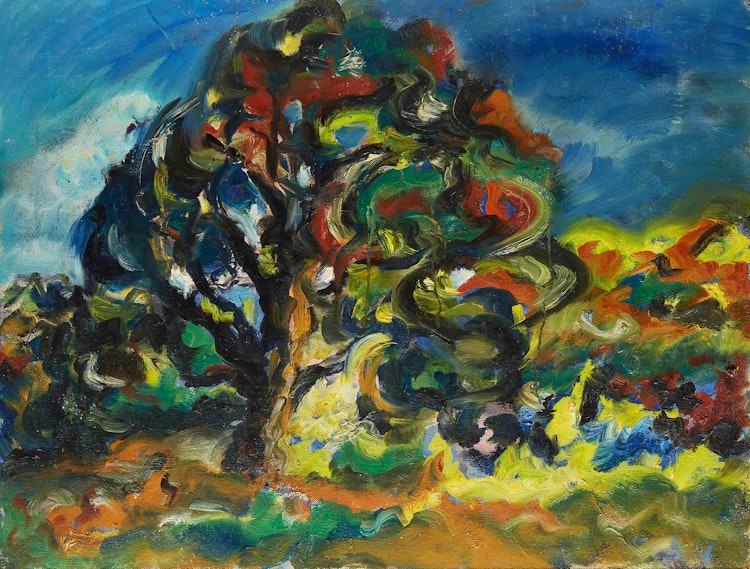June by Gershon Iskowitz

Gershon Iskowitz
June
oil on canvas board
signed, titled, dated 1955 and inscribed “B22” & “Joyce N.F.S.” on the reverse; unframed
18 x 23.75 ins ( 45.7 x 60.3 cms )
Auction Estimate: $3,000.00 - $5,000.00
Price Realized $4,800.00
Sale date: April 27th 2021
Collection of the artist
Gershon Iskowitz Foundation
The environs of Parry Sound were more than subject matter; it also served as an armature for Iskowitz to express and develop form and colour through nature observed. “June” (which may refer to the month, a titling convention that Iskowitz continued through his career) is an early tree and landscape composition but bears the hallmarks of fluid brushwork and vivid colours that would appear in his fully abstract paintings and watercolours ten years later. Similar period and subject Parry Sound painting are held in the collections of the Art Gallery of Ontario, Musée des beaux-arts de Montréal, Art Gallery of Hamilton, The Robert McLaughlin Gallery, and the University of Lethbridge Art Gallery. Trees continued as a compositional source for more ambitious and abstracted works, such as “Late Summer Evening”, 1962 (held by the Gershon Iskowitz Foundation):
https://www.aci-iac.ca/art-books/gershon-iskowitz/key-works/late-summer-evening
No exhibition history is recorded for “June” but was possibly shown in his first solo exhibition at The Hayter Gallery, Toronto, in September 1957.
Proceeds from this sale will benefit the charitable not-for-profit Gershon Iskowitz Foundation, which awards an annual prize to a professional Canadian visual artist for their ongoing research and artistic production.
Share this item with your friends
Gershon Iskowitz
(1919 - 1988) RCA
Born in Kielce, Poland, in 1919, Gershon Iskowitz immigrated to Canada in 1948 after surviving two Nazi concentration camps (Auschwitz labour camp in Poland and later Buchenwald, near Weimar, Germany). As a child, Iskowitz had an aptitude for art. He created advertisements for his local movie theatre in a section of his family’s living room that his father portioned off to create a small studio.
Following the Nazi occupation of Poland, Iskowitz was placed in the Kielce Ghetto. Once liquidated, Iskowitz was imprisoned in concentration camps in Poland and Germany. While he continued to make drawings during this period only two survive: Condemned (1944-46) and Buchenwald (1944-45). Upon liberation, he lived in the Feldafing Displaced Persons Camp and audited courses at the Academy of Fine Arts in Munich.
Upon receiving a temporary travel document from the Military Government for Germany, issued to stateless people, Iskowitz traveled to Canada via the United States in 1948 where his extended family greeted him at Union Station in Toronto. Until 1954, Iskowitz’s paintings focused on memories from his imprisonment. In the same year, he was included in the Canadian Society of Graphic Art exhibition at the Art Gallery of Ontario (AGO) alongside Painters Eleven artist Oscar Cahén.
By the 1960s Iskowitz’s style transformed from gestural to abstract. He became interested in exploring the Canadian landscape rather than his wartime memories during this period. After exhibiting at Gallery Moos in October 1964, for the first time, Iskowitz formed a close relationship with the owner, Walter Moos. Moos managed Iskowitz’s career and finances from this point forward. After receiving a Canada Council grant in 1967 he flew to Churchill, Manitoba. Entranced by aerial views he saw while in flight, Iskowitz began incorporating this perspective into his art.
Iskowitz was selected to represent Canada alongside Walter Redinger at the Venice Biennale in 1972 where he displayed four of these areal diptychs. In 1982, the AGO put on a retrospective exhibition of Iskowitz’s life work. After the retrospective exhibition had concluded, Iskowitz set up a foundation that would provide financial support to artists through an annual monetary prize, with assistance from Moos.
Literature Source: Ihor Holubizky, Gershon Iskowitz: Life and Work. Toronto: Art Canada Institute, 2018 (https://aci-iac.ca/art-books/gershon-iskowitz)
We extend our thanks to Danie Klein, York University graduate student in art history, for writing and contributing this artist biography.

